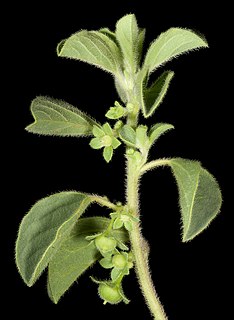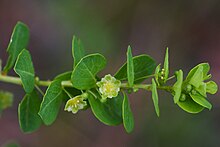
Phyllanthus is the largest genus in the plant family Phyllanthaceae. Estimates of the number of species in this genus vary widely, from 750 to 1200. Phyllanthus has a remarkable diversity of growth forms including annual and perennial herbs, shrubs, climbers, floating aquatics, and pachycaulous succulents. Some have flattened leaflike stems called cladodes. It has a wide variety of floral morphologies and chromosome numbers and has one of the widest range of pollen types of any seed plant genus.

Phyllanthaceae is a family of flowering plants in the eudicot order Malpighiales. It is most closely related to the family Picrodendraceae.

Ochnaceae is a family of flowering plants in the order Malpighiales. In the APG III system of classification of flowering plants, Ochnaceae is defined broadly, to include about 550 species, and encompasses what some taxonomists have treated as the separate families Medusagynaceae and Quiinaceae. In a phylogenetic study that was published in 2014, Ochnaceae was recognized in the broad sense, but two works published after APG III have accepted the small families Medusagynaceae and Quiinaceae. These have not been accepted by APG IV (2016).

The family Pandaceae consists of three genera that were formerly recognized in the Euphorbiaceae. Those are:

Panicoideae is the second-largest subfamily of the grasses with over 3,500 species, mainly distributed in warm temperate and tropical regions. It comprises some important agricultural crops, including sugarcane, maize, sorghum, and switchgrass.

Leptopus, the maidenbushes, are a genus of plants in the family Phyllanthaceae native to southern Asia from the Caucasus east to China and Maluku. The plants are monoecious herbs and shrubs with simple, entire leaves and small, green flowers.

Bischofia is a genus of plants in the family Phyllanthaceae first described as a genus in 1827. It is native to southern China, the Indian Subcontinent, Queensland, New Guinea, and various islands of the Pacific. It is the only member of the tribe Bischofieae. They are dioecious, with male and female flowers on separate plants, but may rarely be monoecious.
Thecacoris is a genus of flowering plant belonging to the family Phyllanthaceae first described as a genus in 1821. It is native to tropical Africa and Madagascar. It is dioecious, with male and female flowers on separate plants, although it may rarely be monoecious.

Poranthera is a genus of flowering plant belonging to the family Phyllanthaceae first described as a genus in 1811.
Andrachne is a genus of flowering plants in the family Phyllanthaceae described by Linnaeus in 1753. It is one of eight genera in the tribe Poranthereae.
Chorisandrachne is a genus of plants in the family Phyllanthaceae first described as a genus in 1969. It contains only one known species, Chorisandrachne diplosperma, native to southern Thailand.
Meineckia is a genus of flowering plants in the family Phyllanthaceae first described as a genus in 1858.

Securinega is a genus of plants in the family Phyllanthaceae, first described as a genus in 1789. As presently conceived, the genus is native to Madagascar and the Mascarene Islands in the Indian Ocean. In the past, it was considered to be much more widespread, thus explaining the long list of species formerly included. It is dioecious, with male and female flowers on separate plants.
- Securinega antsingyensisLeandri - W Madagascar
- Securinega capuroniiLeandri - W Madagascar
- Securinega durissimaJ.F.Gmel. - Madagascar, Mauritius, Réunion, Rodrigues Island
- Securinega perrieriLeandri - W Madagascar
- Securinega seyrigiiLeandri - W Madagascar

Actephila is a genus of plants in the family Phyllanthaceae, first described as a genus in 1826. It is one of 8 genera in the tribe Poranthereae, and is most closely related to Leptopus. The name of the genus is derived from two Greek words, akte, "the seashore", and philos, "loving". It refers to a coastal habitat.
Poranthereae is a tribe in the plant family Phyllanthaceae. It is one of ten tribes in the family, and one of four tribes in the subfamily Phyllanthoideae. Poranthereae comprises about 111 species, distributed into eight genera. The largest genera and the number of species in each are Actephila (31), Meineckia (30), and Andrachne (22).
Pseudophyllanthus is a monotypic genus of flowering plants in the family Phyllanthaceae. It is one of the eight genera in the tribe Poranthereae. Its closest relative is Poranthera. Its sole species is Pseudophyllanthus ovalis.

Notoleptopus is a monotypic genus of flowering plants in the family Phyllanthaceae. It is one of eight genera in the tribe Poranthereae. The sole species is Notoleptopus decaisnei. It is a monoecious shrub, native to Australia, New Guinea, and Indonesia.

Vittarioideae is a subfamily of the fern family Pteridaceae, in the order Polypodiales. The subfamily includes the previous families Adiantaceae and Vittariaceae.
Phyllanthopsis arida, the trans-Pecos maidenbush, is a rare plant species endemic to western Texas.

Paspaleae is a tribe of the Panicoideae subfamily in the grasses (Poaceae), native mainly to the tropical and subtropical Americas but with a number of species introduced to other regions. It includes roughly 680 species in 39 genera. Species in this tribe use either of the C3 or C4 photosynthetic pathways.













